Standing on Horses – Part 19
|
|
Auf Pferden stehen – Teil 19
|
- Standing on horses is fun and not as hard as it looks.
|
|
- Auf Pferden stehen macht Spaß und ist gar nicht so schwer.
|
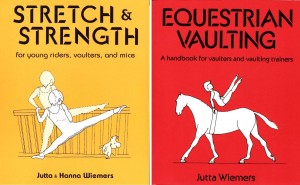 Stretching is part of your homework! A pre-requisite for all good performance. You can’t ask your horse to be an athlete, if you are not willing to try yourself! |
- The vaulting book shows you how to learn building up the stand in the safest way (See picture end of this Blog). Once you can jump off the height of the horse without worry and with soft landings on the ground, you are ready for these games!
|
|
- Im “Vaulting Handbook” ist gezeichnet wie man das Stehen am sichersten erlernt (siehe letztes Bild im Blog). Sobald man aus der Pferdehöhe sicher abspringen und weich landen kann ist man für diese Spiele bereit!
|
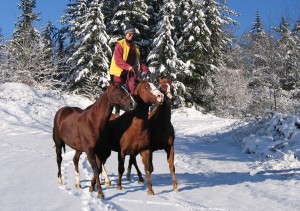 I have the outer horses on a lead rope only to hold less in my hands |
- When riding the “Troika” I only use halters. Like this the horses can never get hurt in the mouth in case of a loss of balance. The centre horse has two reins clipped to it, the others just need an outer rope, so I have less equipment in my hands. For the game “Two-in-Front” we of course first learn in the sitting position, as long-reining the two front ones needs a bit of practice. Make sure an assistant helps you at the beginning!
|
|
- In der “Troika” benutze ich nur Halfter. So kann ich bei einem Verlust der Balance nie den Pferden im Maul wehtun. Das mittlere Pferd hat zwei Zügel eingeschnallt, die äußeren nur ein Seil, damit ich weniger in der Hand halten muß. Das “Zwei-Vorn” Spiel lernen wir natürlich erst im Sitzen, da das Dirigieren am langen Zügel der vorderen ein bißchen Übung braucht. Am Anfang sollte man einen Gehilfen haben!
|
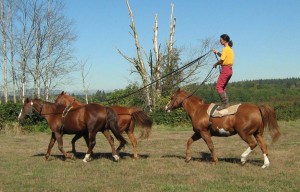 Attach the reins to halters only, so there is no danger of hurting the horses’ mouths |
- The front horses are coupled together with neck straps – otherwise they would not necessarily agree on the same direction! We also use longing surcingles and pass the long reins through the rings, making sure nothing can get snagged, dragged or otherwise caught up and become dangerous to us all.
- In the Hungarian Post the rider stands on two horses – again connected via neck straps to avoid having to perform the splits! Use a helper in the front to start out. To balance this in walk and trot is really quite simple – and you would start with only two horses to learn!
|
|
- Die vorderen Pferde sind mit Halsriemen gekoppelt – sie sind sich sonst oft nicht in der Richtung einig! Auch benutzen wir Gurte und legen die Longe durch die Ringe, damit nichts verheddern und gefährlich werden kann.
- In der Ungarischen Post steht der Reiter auf zwei Pferden – die wieder Halsriemen anhaben, damit man nicht etwa Spagat machen muß! Ein Assistent hilft anfangs vorne mit. Dies im Schritt oder Trab auszubalancieren ist gar nicht schwer – man fängt natürlich erst mal mit nur zwei Pferden an!
|
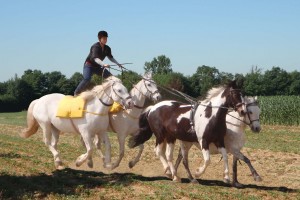 The more horses you work at once, the sooner you can go home! |
- Anna has advanced to four horses and performs in full gallop! See her on film! (“Playing with Horses” Equestrian Vision)
|
|
- Anna macht es schon mit Vieren und in flottem Galopp! Bewundert sie auf dem Film! (“Playing with Horses” auch deutsch! Equestrian Vision)
|
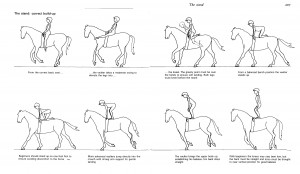 Standing on horses is not as hard as it looks |
Have Fun !!
|
|
Viel Spaß !!
|